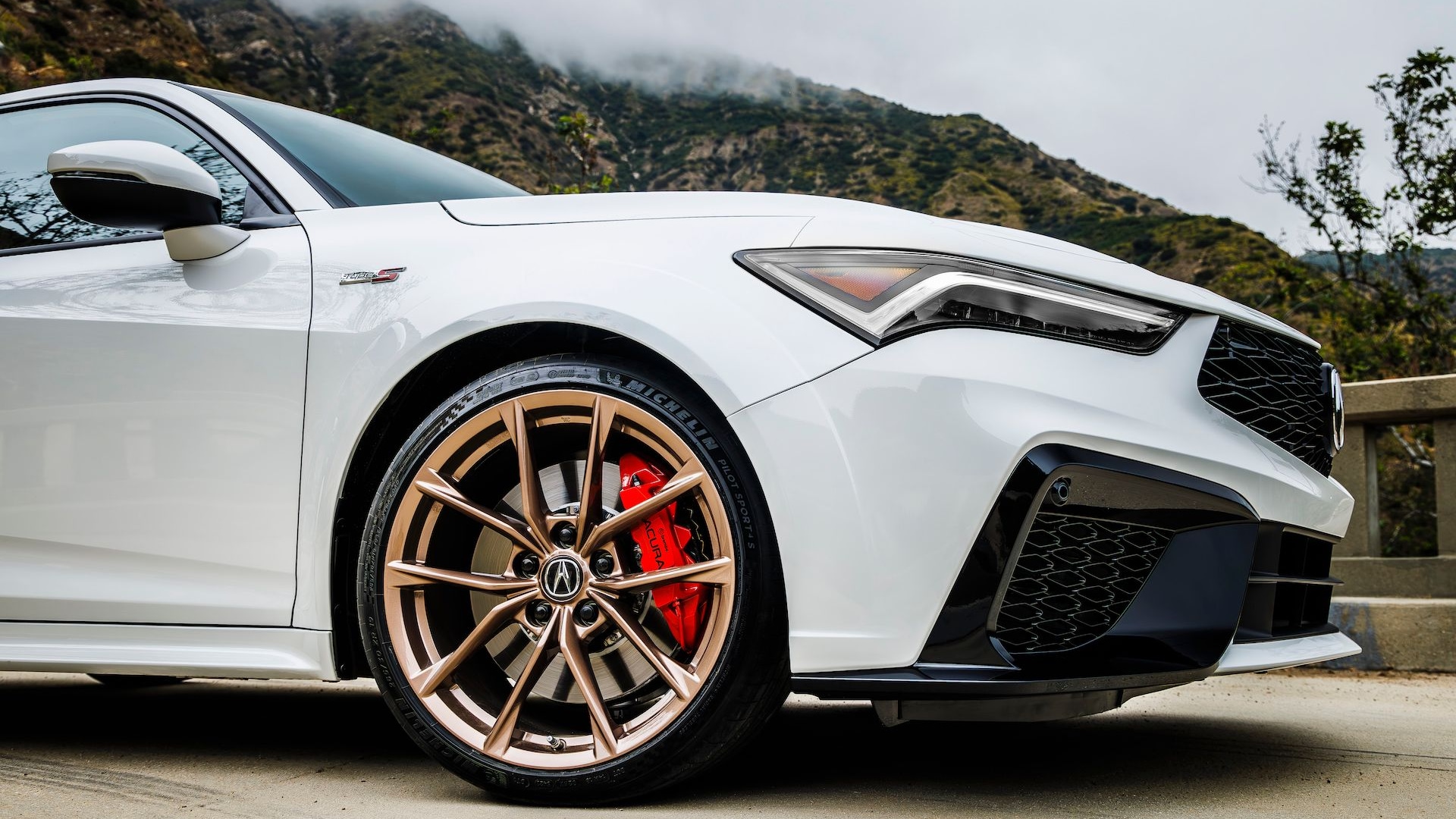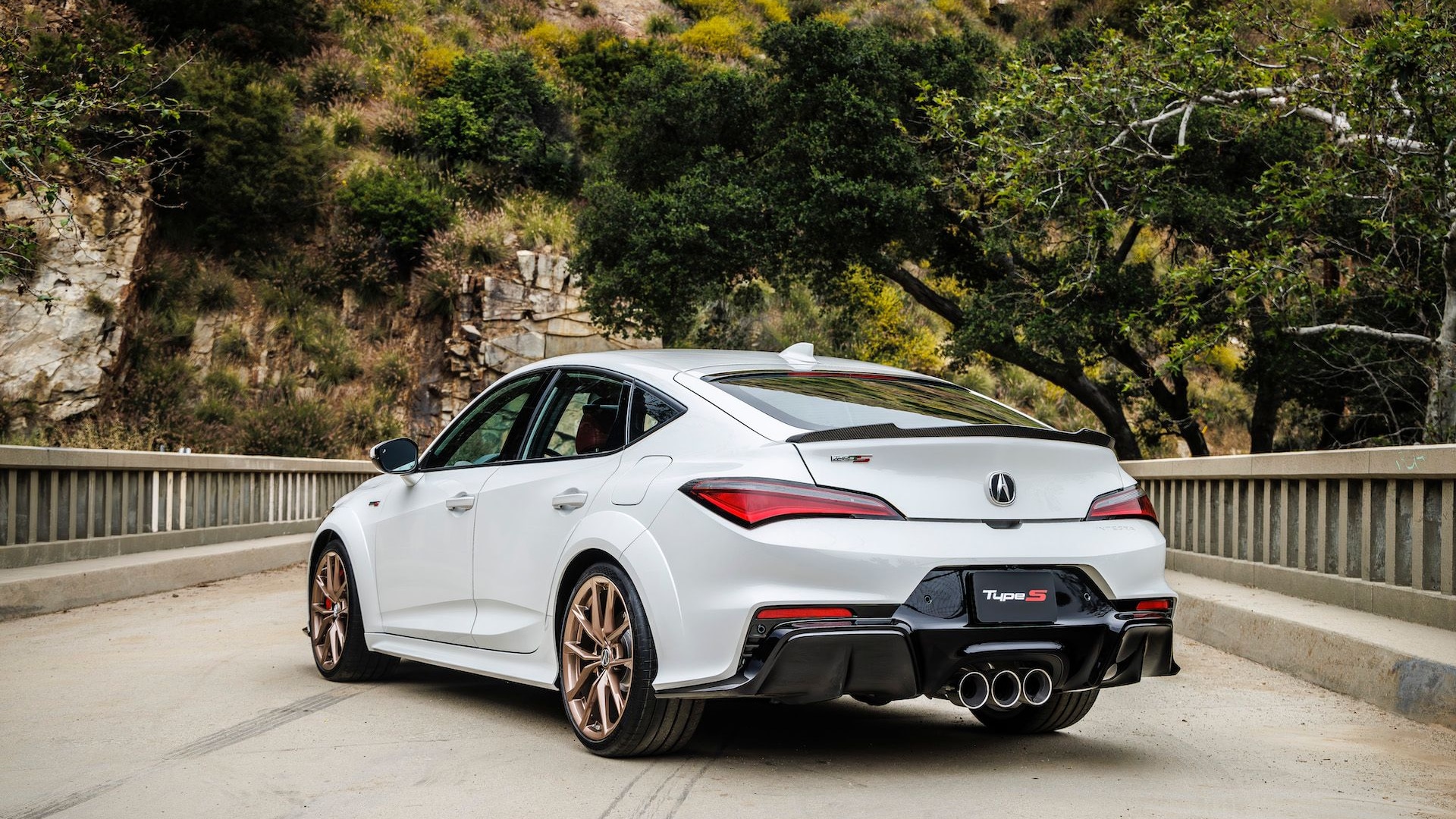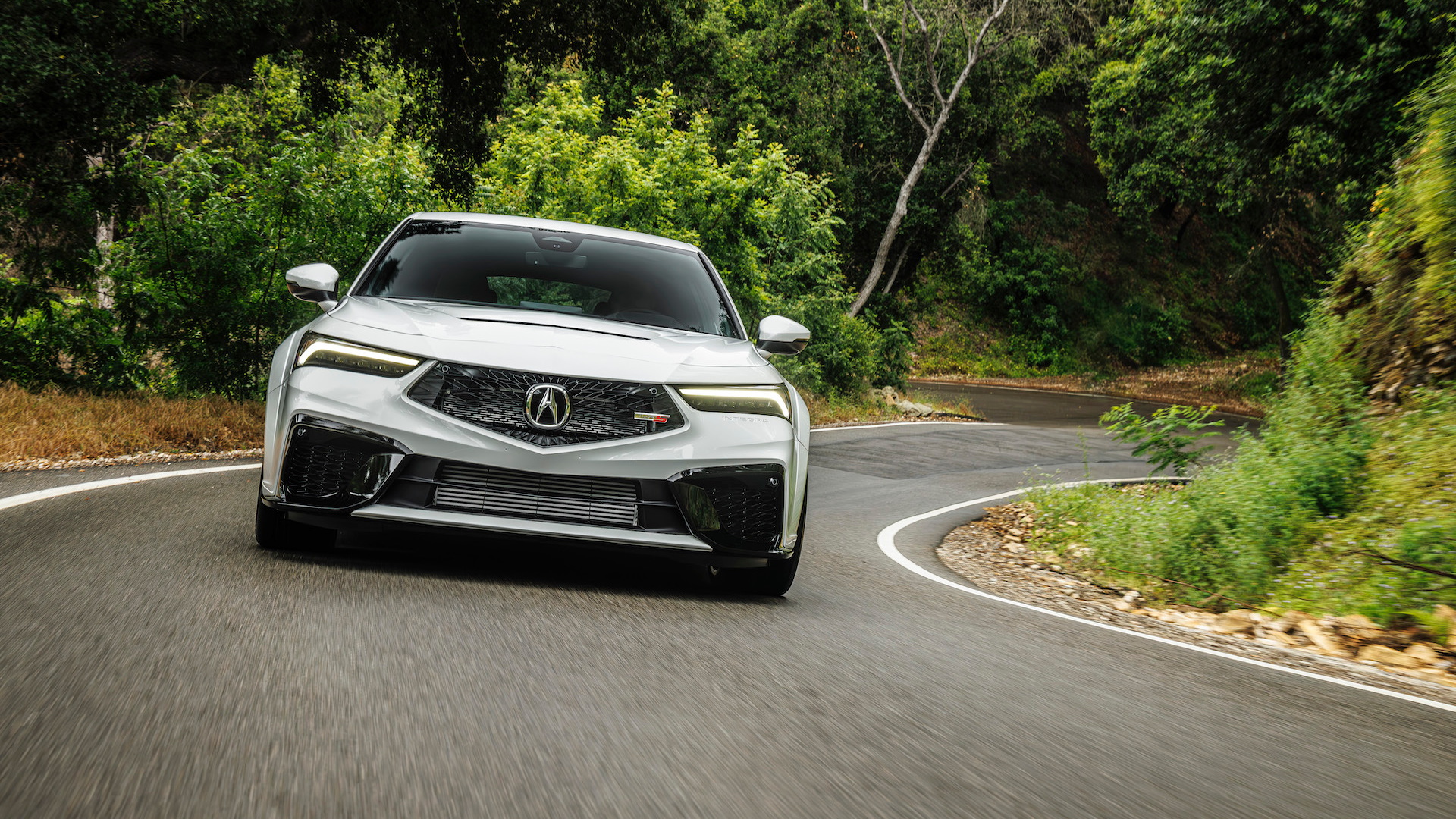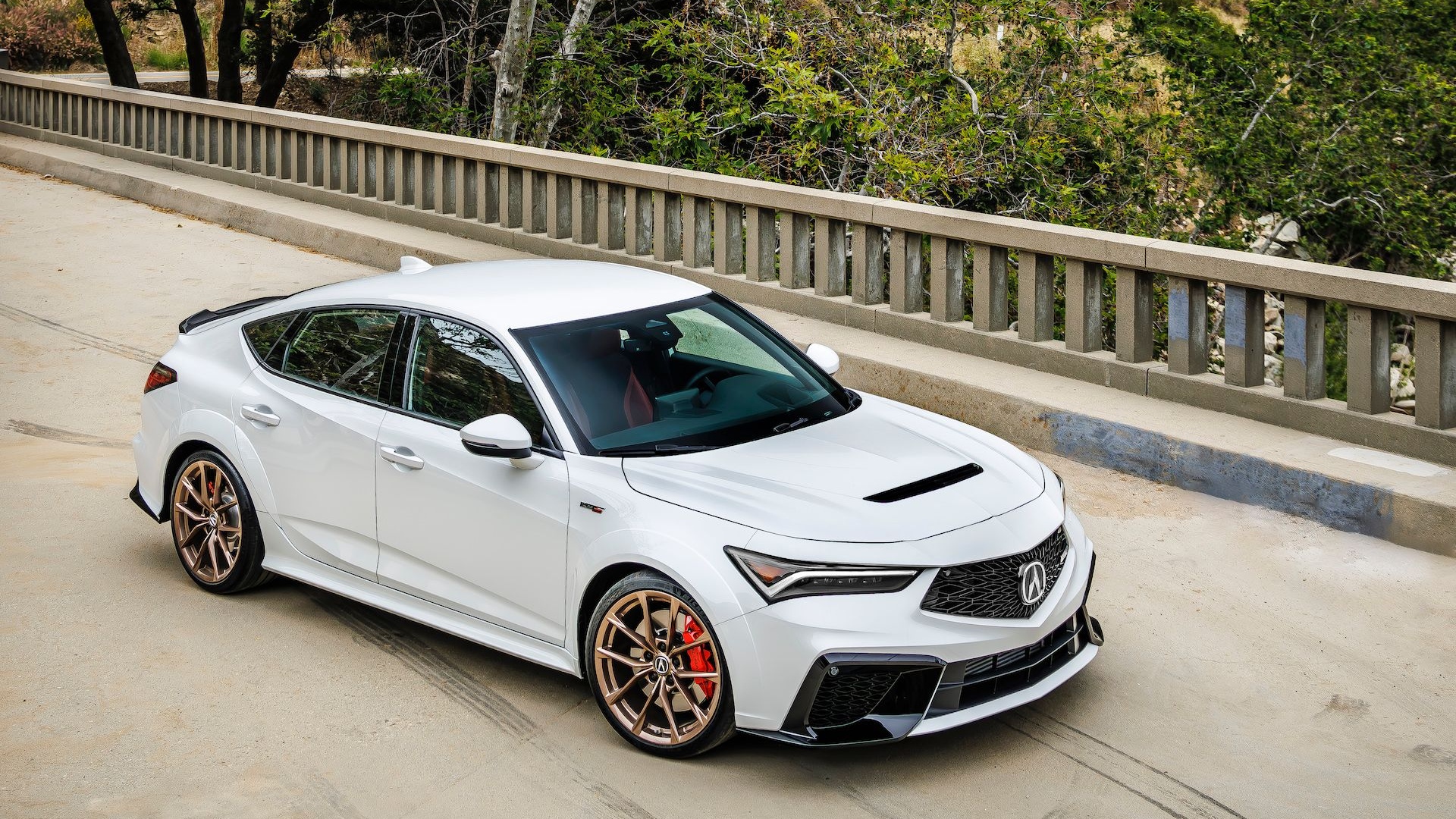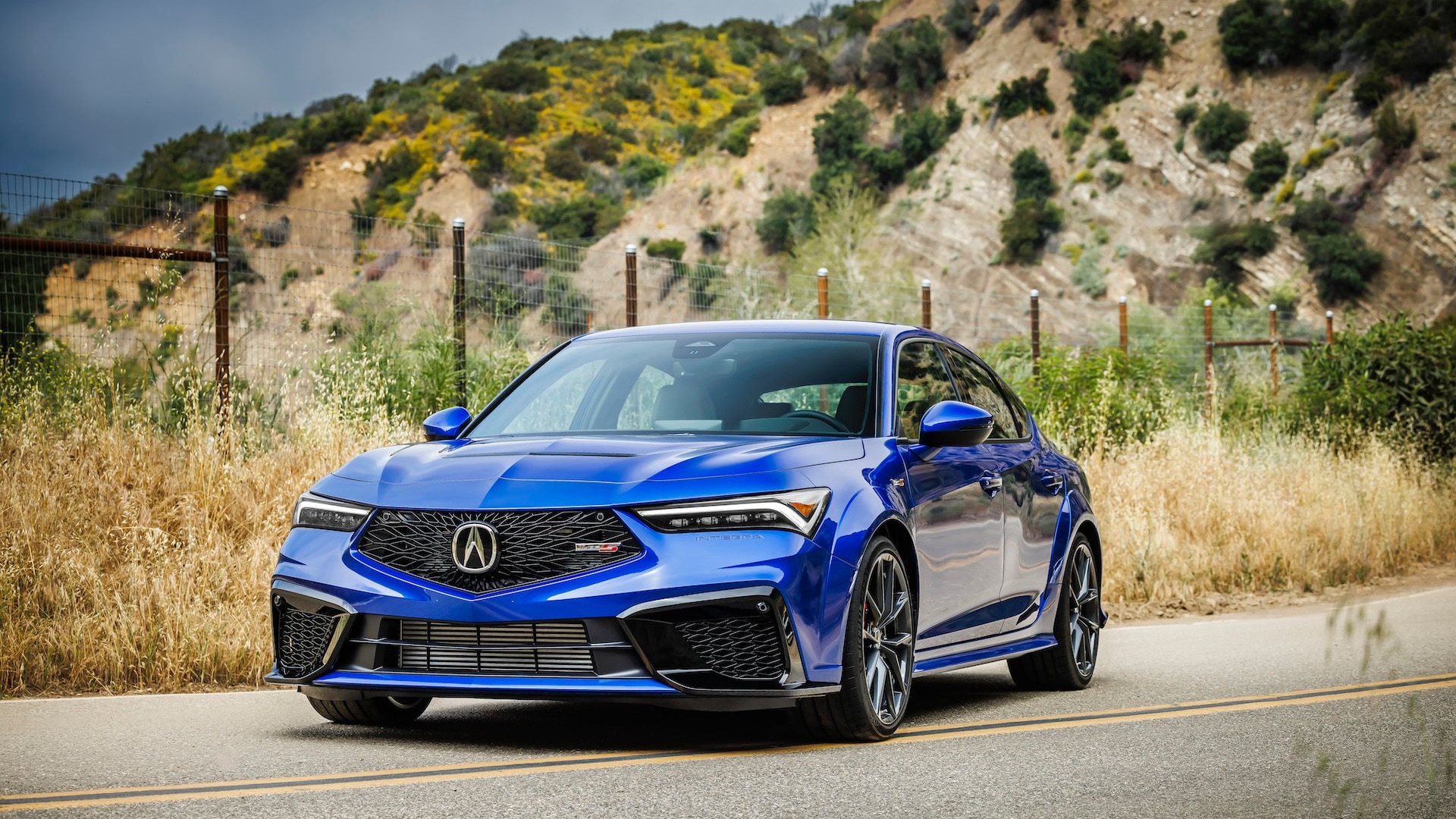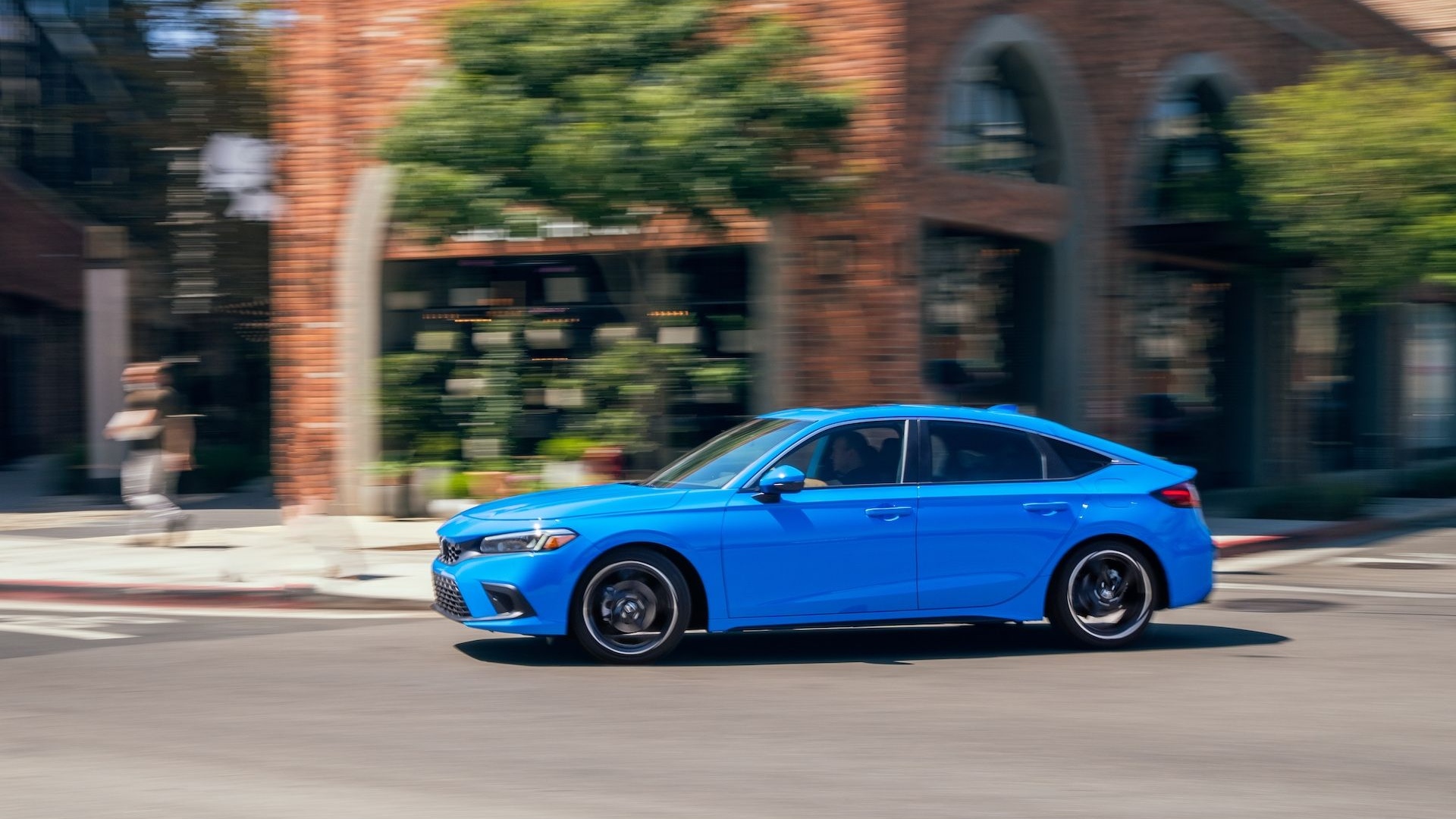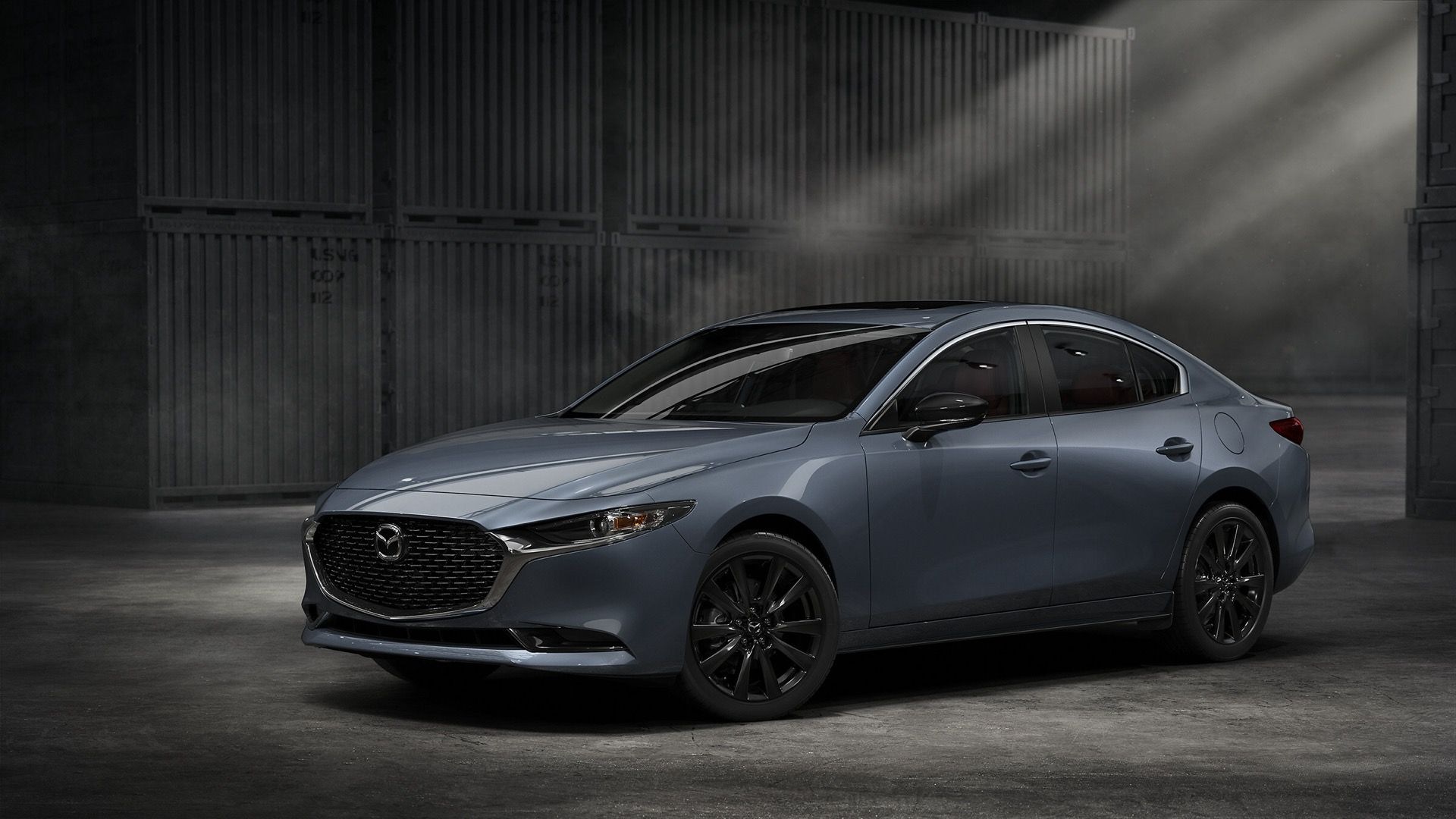Stuck behind a dump truck going 14 mph through one of the towns that dot Hwy 154 in Southern California, I can’t help but think Acura is selling the 2024 Integra Type S short on this first drive program. I shouldn’t be frustrated by slowpokes. I should be negotiating the corkscrew at Laguna Seca.
Not all of this route is so tame—it opens up into some fun canyon roads later—but this is a street drive instead of a track drive because Acura is touting the Integra Type S as a more mature street car than the related Honda Civic Type R, which is billed as a track machine. The Civic Type R may be slightly sharper, but the Integra Type S is no less capable and more inviting to boot.
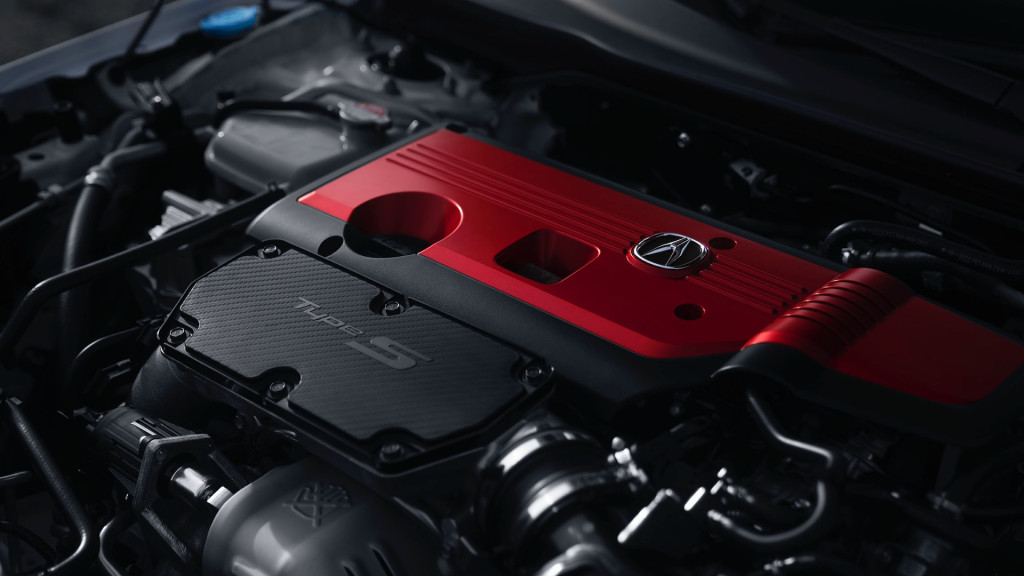
2024 Acura Integra Type S
Acura Integra Type S: Rowdy power
The Integra Type S and Civic Type R share a basic structure, a powertrain, and suspension. Even the tires are the same right down to the size and brand.
The engine is the one element of the Integra Type S that has a sharper edge than the Civic Type R, but only slightly. It’s the same 2.0-liter turbo-4 with the same 25.2 psi of boost that gives it incredible power. Here, it makes 320 hp at 6,500 rpm and 310 lb-ft of torque from 2,600-4,000 rpm. That beats the Civic Type R by 5 hp, but Acura says the Integra Type S is also programmed for better mid-range torque.
The Integra Type S can launch from 0-60 mph in a tad over five seconds, and here it’s chomping at the bit to run free and unfettered from traffic. It’s a torque-rich engine with strong responses from a stop. It’s also responsive in the mid-range and all the way up to its 7,000-rpm redline, though any difference between the Type S and Type R would require back-to-back drives that aren’t available here.
Like the Civic Type R, getting the Integra Type S to launch hard is tricky, as power goes only through a 6-speed manual transmission to the front wheels and Acura provides no launch control function.
I try a couple of hard starts and find it’s best to launch at about 2,000 rpm with about three-quarter throttle. Revving much higher than that causes the wheels to spin when you come off the clutch, and Acura has an rpm cut-off at 3,400 rpm that retards the power. The front end reacts admirably, too, giving only the hint of torque steer without a hard pull to one side or the other. Acura limits torque steer with equal-length half-shafts, a mechanical limited-slip differential, and a dual-axis MacPherson strut front suspension that separates the knuckles and dampers.
The engine is even chattier than in the Type R, at least from the outside of the car. It has essentially the same exhaust system as the Honda with a single exhaust valve and three center-mounted 4.3-inch outlets, but it lacks the Honda’s front resonator and thus the louder sound. That sound comes in two stages, as the valve opens at higher rpm with the car in the Comfort drive mode, lower rpm in Sport mode, and always stays open in Sport Plus. Sport Plus also triggers some pops and bangs from the exhaust on downshifts, upshifts, deceleration, or when revving the engine.
From the driver seat, the engine certainly makes its angry beehive noises heard, but they don’t interfere with conversation because the Integra has more sound deadener than the Civic. I didn’t even notice the pops and bangs, or the sound of the blow-off valve, until I rolled down the windows.
The manual transmission is a typical Honda/Acura delight, with short throws, positive engagement, and a great feel through its metal and leather shift knob. My only complaint is a light clutch with a high engagement point that requires a few shifts to get used to.
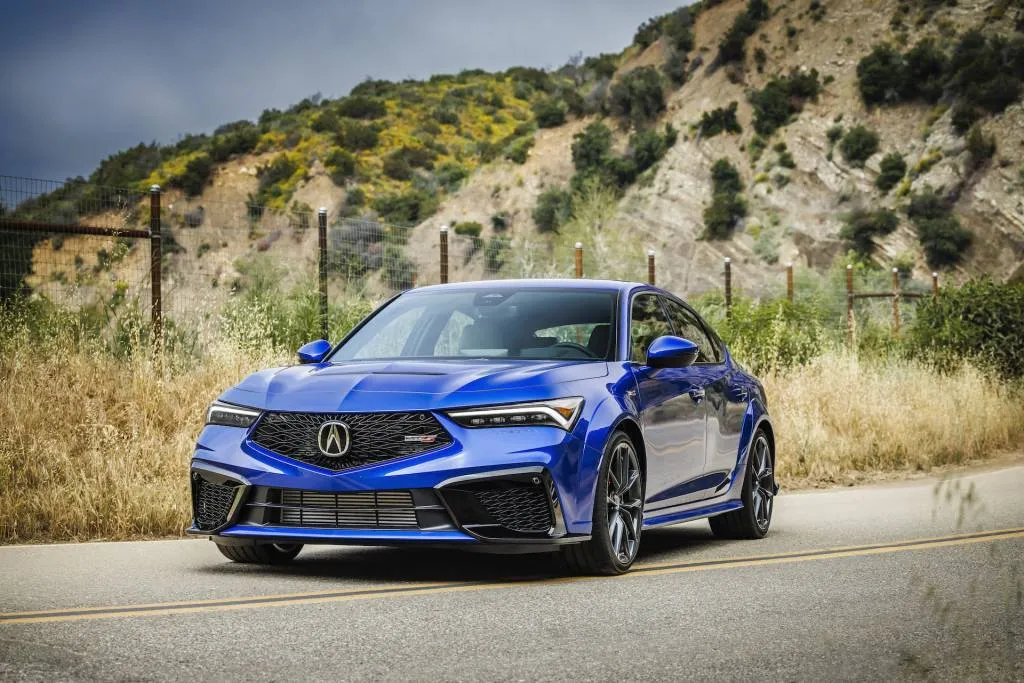
2024 Acura Integra Type S

2024 Acura Integra Type S

2024 Acura Integra Type S
Acura Integra Type S: Front-drive wonder
The Integra Type S’s front-wheel-drive layout also isn’t ideal for handling, but you wouldn’t know it by driving the car. It takes its place with the Civic Type R as the best handling front-wheel-drive cars on the market.
Acura upgrades the standard Integra to get there. In fitting the different suspension components from the Civic Type R under the Integra, Acura engineers widened the front track 3.5 inches and the rear track 1.9 inches. The tubular front stabilizer bar is 2 mm wider at 29 mm, and the solid rear bar is 2 mm wider than the one on the A-Spec Integra at 20.5 mm. The multilink rear suspension also has high-rigidity knuckles and unique bushings made from a material Acura would not divulge. It all reacts through a sport-tuned version of the Integra’s three-way adjustable dampers. The body structure hasn’t changed, but Acura adds more bonding material.
The suspension makes room for bigger wheels and tires as the Type S rolls on 265/30R19 Michelin Pilot Sport 4Ss mounted on 19 x 9.5-inch wheels at each corner. The wheels may be bigger than the A-Spec model’s 18s, but they’re 6.5% lighter.
While the variable steering ratio is actually slightly slower than on other Integras, it’s still very quick with a ratio that ranges from 11.62:1 at full lock to 14.9:1 on center. The brakes also grow 1.5 inches up front to 13.8 inches with Brembo 4-piston calipers and 0.9 inch in the rear to 12.0 inches with single-slot calipers.
With power sent only through the front wheels, those Michelins have to manage the acceleration and steering, and carry most of the braking force, and they do it all well.
The open canyon roads I experience later in the day reveal much but not all of the hatchback’s handling prowess.
Like other Integras, the Type S has weighty, direct steering that firms up even more at highway speeds to improve high-speed stability. The car turns in to corners quickly, and the rear end follows along dutifully. It waterbugs through ess turns, and puts its power down efficiently when accelerating out of corners thanks to the wide tires and limited-slip diff.
Those tires can only do so much, though, so balancing the weight for turning, accelerating, and braking is important. When too much speed makes it push in a corner, letting off the throttle or a small dab of brake tucks the nose in nicely to carve through the turn. When exiting a corner too fast, it will run wide, but a little less throttle gets it back on track.
This is all easy to feel thanks to a little bit of body lean, no matter the damper setting, through the well-tuned suspension. In each of the three damper modes—Comfort, Sport, and Sport+—the Integra Type S is a half step softer than the Civic Type R’s suspension, which we found created a too-busy ride on broken pavement. Comfort provides an everyday comfortable ride quality, Sport+ borders on hard over bumps, and Sport is the sweet spot for twisty roads.
Overall, the Type S feels like it has all the performance of the Type R. It would probably put up about the same time around a track like Laguna Seca, but it’s more comfortable on the street. That fits with the car’s more grown-up character, which is also reflected in its looks and equipment.

2024 Acura Integra Type S

2024 Acura Integra Type S

2024 Acura Integra Type S
Acura Integra Type S: The grown-up choice
The Integra Type S sports a variety of exterior changes to improve performance.
Up front, it wears a larger, more open grille with a diamond-pattern mesh and 170% more airflow than other Integras. This air cools the engine and flows through a vent in the aluminum hood for lift reduction. The lower fascia has larger air intakes with areas for brake cooling and canards that help create air curtains around the front wheels.
Wider lower sills match wheel flares that make the car 2.8 inches wider than other Integras, and the rear end has an integrated lip spoiler and a gloss-black diffuser with triple center-exit exhaust finishers.
The changes give the Integra Type S a purposeful stance that doesn’t stray too far into boy racer territory thanks mostly to the lack of a Civic Type R-like rear wing. That may mean the Acura has slightly less downforce on a track than the Honda, but it’s a fair price to pay to drive a car with a design that exercises wise restraint.
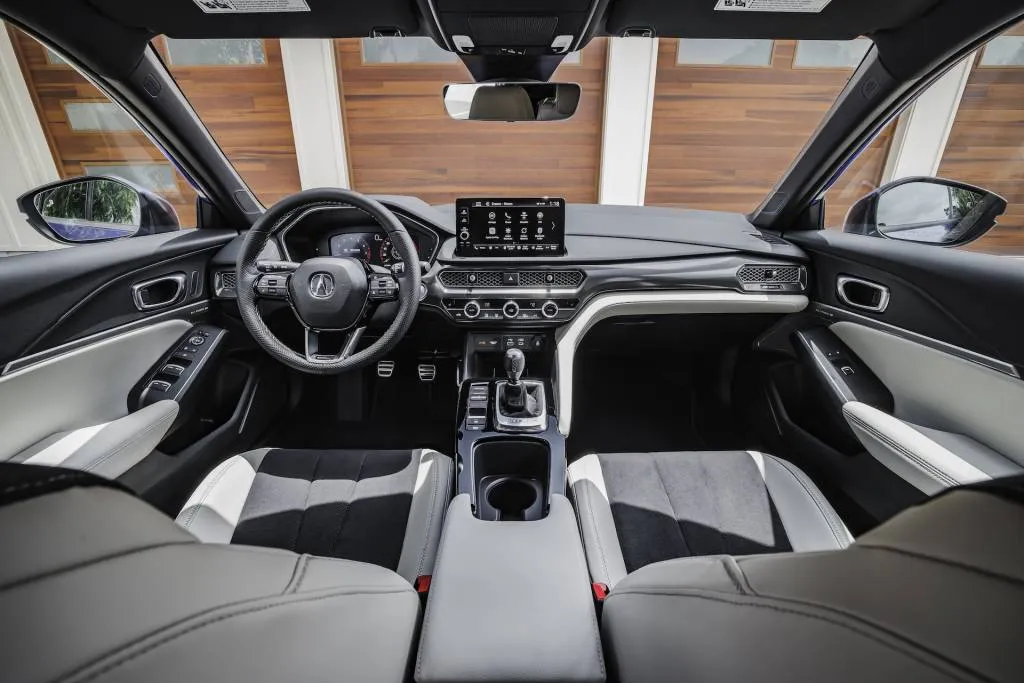
2024 Acura Integra Type S

2024 Acura Integra Type S

2024 Acura Integra Type S
The interior changes much less. The seats have the same design as in other Integras but they get firmer bolsters, synthetic suede inserts, and contrast stitching. Heated and with eight-way power adjustments and four-way power lumbar adjustments, they’re sporty and comfortable seats, but they aren’t as firm as the Recaros and more extreme sport seats offered by other manufacturers. Bigger folks will appreciate that, but smaller people may not; I like them. The rear seat is shaped for two passengers instead of the standard three of other Integras.
The interior also features a perforated leather steering wheel and shift knob, a synthetic suede shift boot with colored stitching, and a lower dash that is color-matched to the buyer’s choice of Red, Ebony, or Orchid interior colors.
Acura also outfits the Type S with luxury car levels of standard equipment, including a 10.2-inch digital instrument cluster, a 9.0-inch touchscreen, a head-up display, 16-speaker ELS audio, wireless Apple CarPlay and Android Auto, and wireless smartphone charging.
Standard safety features consist of blind-spot monitors, rear cross-traffic alerts, automatic emergency braking with pedestrian detection, active lane control, adaptive cruise control, front and rear parking sensors, and traffic sign recognition.
This all comes for a price of $51,995 including an $1,195 destination fee. That’s about $10,000 more than the Civic Type R, which won the Motor Authority Best Car To Buy 2023 award. However, the Integra Type S is more civil than the Civic and better equipped. It can also likely perform just as well as long as a slow-moving dump trunk isn’t blocking the way. We’ll aim to make that happen during our Motor Authority Best Car To Buy 2024 testing later this year.
Acura paid for travel and lodging for Motor Authority to bring you this firsthand report.
